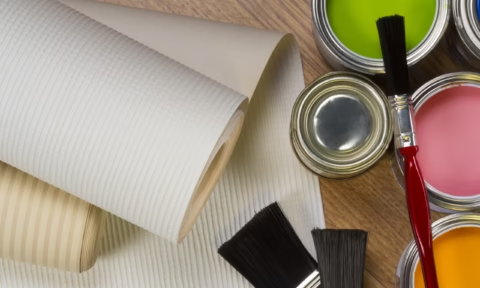Wallpaper is no longer confined to walls. With its versatility, textures, patterns, and colors, wallpaper is a tool for creativity, enabling you to elevate your décor in unexpected ways. This blog explores 10 innovative ways to use wallpaper beyond traditional applications and how you can give everyday items a stylish upgrade. Let’s dive into this world of endless possibilities.
Transform Furniture into Statement Pieces
Wallpaper can breathe new life into old furniture. Apply it to tabletops, drawer fronts, or cabinet doors for a bold, unique look. Choose patterns that complement your room’s aesthetic to create a seamless blend.
Pro Tip: Use peel-and-stick wallpaper for easy application and removal when you want to refresh the look.
Design Unique Ceiling Art
The ceiling is often referred to as the “fifth wall.” Applying wallpaper with intricate patterns or calming tones can make a room feel taller or more cozy, depending on the design. This unexpected detail can transform any room into a visual masterpiece.
Best For: Bedrooms, dining areas, or even kids’ playrooms.
Revamp Stairs with Patterned Risers
Wallpapering the risers of a staircase adds personality to an often-overlooked area. Choose a bold design for a striking effect or a subtle pattern for an elegant touch.
Maintenance Tip: Ensure the mural is securely applied to withstand foot traffic and occasional bumps
Customize Shelves and Bookcases
Line the back of shelves or bookcases with wallpaper to create a pop of color or pattern. This trick enhances the display of books, collectibles, or plants, drawing attention to your curated spaces.
Pro Tip: Match the Mural with your room’s color scheme for a cohesive look.
Personalize Lampshades
Turn an ordinary lampshade into a showstopper with wallpaper. Use adhesive wallpaper to cover the exterior or interior of a lampshade, adding a soft glow when the light is turned on.
Best For: Bedrooms, living rooms, or office spaces.
Craft Beautiful Headboards
Wallpaper can be a creative and cost-effective way to create a custom headboard. Use a wooden panel covered with your chosen design or apply it directly to the wall behind the bed.
Tip: Opt for textured or metallic wallpaper for a luxurious effect.
Style Small Decorative Accents
Use wallpaper to decorate smaller items like photo frames, coasters, or decorative trays. These little details can tie your design theme together and make your décor feel curated and intentional.
Best Practice: Use scraps from larger projects to reduce waste.
Upgrade Doors and Door Panels
Plain doors can become focal points with wallpaper. Cover an entire door or just the panels with a complementary or contrasting design to add depth and character.
Ideal For: Closets, pantry doors, or even entryways.
Beautify Planters and Pots
Add a touch of whimsy to your indoor garden by wrapping planters or flowerpots in wallpaper. This idea is perfect for matching plant décor with the overall vibe of your home.
Tip: Seal the wallpaper with a clear waterproof coating for durability.
Create Art Pieces
Why buy expensive artwork when you can create your own? Frame wallpaper swatches as wall art or use multiple designs to craft a gallery wall. The possibilities are limitless when you combine patterns and textures.
Best For: Living rooms, hallways, or home offices.
FAQs About Creative Wallpaper Applications
Yes, wallpaper can transform furniture like dressers, tables, and cabinets into eye-catching statement pieces. Use durable adhesive wallpaper for the best results.
Absolutely! Ceiling wallpaper is a creative way to add depth and interest to a room. Ensure proper adhesion for long-lasting results.
Yes, wallpaper works well on glass surfaces, but ensure you choose a material designed for non-porous surfaces, like peel-and-stick varieties.
Clean and sand the surface before application, and use a strong adhesive or peel-and-stick wallpaper for durability.
Wallpaper is generally not designed for outdoor use. However, vinyl-based or waterproof wallpapers may work in semi-outdoor spaces like patios.
You’ll need a cutting tool, ruler, wallpaper adhesive or spray, and a smoothing tool for a clean finish.
Regularly clean with a damp cloth and avoid abrasive cleaning materials to preserve the wallpaper's integrity.

















